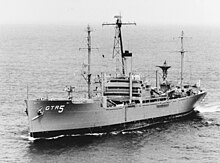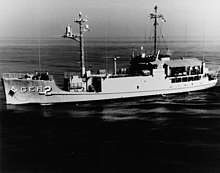
USS Liberty (AGTR-5) was a Belmont-class technical research ship that was misidentified and attacked by Israel Defense Forces during the 1967 Six-Day War. She was originally built and served in World War II as a VC2-S-AP3 type Victory cargo ship named SS Simmons Victory. Her keel was laid down on 23 February 1945, under a Maritime Commission contract at Oregon Shipbuilding Corporation of Portland, Oregon.

The Victory ship was a class of cargo ship produced in large numbers by North American shipyards during World War II to replace losses caused by German submarines. They were a more modern design compared to the earlier Liberty ship, were slightly larger and had more powerful steam turbine engines, giving higher speed to allow participation in high-speed convoys and make them more difficult targets for German U-boats. A total of 531 Victory ships were built in between 1944 and 1946.

USS Pueblo (AGER-2) is a Banner-class environmental research ship, placed into service during World War II, then converted to a spy ship in 1967 by the United States Navy. She gathered intelligence and oceanographic information, monitoring electronic and radio signals from North Korea. On 23 January 1968, the ship was attacked and captured by a North Korean vessel, in what became known as the "Pueblo incident", or alternatively, as the "Pueblo crisis".

A spy ship or reconnaissance vessel is a dedicated ship intended to gather intelligence, usually by means of sophisticated electronic eavesdropping. In a wider sense, any ship intended to gather information could be considered a spy ship.
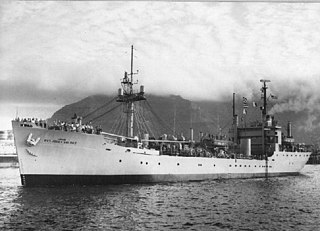
USNS Private Jose F. Valdez (T-AG-169), named after World War II Medal of Honor recipient PFC Jose F. Valdez, was a technical research ship in operation during the 1960s. The "Galloping Ghost of the Ivory Coast" or "Grey Ghost of the African Coast", as she was affectionately called by her crew, was deployed around Africa from 1961 until 1969.

USS Georgetown (AGTR-2/AG-165), was an Oxford-class technical research ship acquired by the U.S. Navy to provide a seaborne platform for global eavesdropping on behalf of the National Security Agency. Her designation as a "technical research" ship was her cover story.

USS Oxford (AGTR-1/AG-159) was an Oxford-class technical research ship, acquired by the U.S. Navy in 1960 and converted for the task of conducting "research in the reception of electromagnetic propagations". She was originally built during World War II as a Liberty-type cargo ship originally named the Samuel R. Aitken.
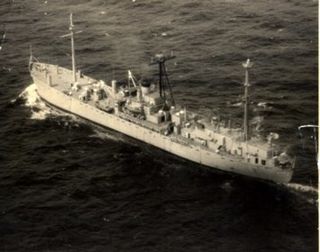
USS Jamestown (AGTR-3/AG-166) was an Oxford-class technical research ship acquired by the U.S. Navy for the task of "conducting research in the reception of electromagnetic propagations" (SIGINT).
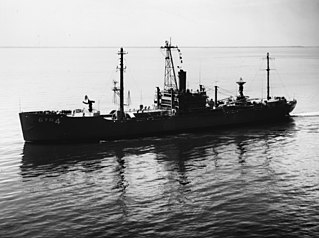
USS Belmont (AGTR-4/AG-167) was the first of two Belmont-class technical research ships,, acquired by the U.S. Navy in 1963 and converted for the task of conducting "research in the reception of electromagnetic propagations". She was originally built during World War II as a Victory cargo ship named SS Iran Victory by the War Shipping Administration's Emergency Shipbuilding program under cognizance of the U.S. Maritime Commission.
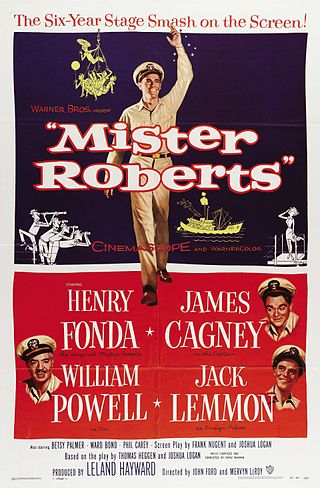
Mister Roberts is a 1955 American comedy-drama film directed by John Ford and Mervyn LeRoy featuring an all-star cast including Henry Fonda as Mister Roberts, James Cagney as Captain Morton, William Powell as Doc, and Jack Lemmon as Ensign Pulver. Based on the 1946 novel and 1948 Broadway play, the film was nominated for three Academy Awards, including Best Picture, Best Sound, and Best Supporting Actor, with Lemmon winning the latter.

USS Hewell (AG-145/AKL-14) was a Camano-class cargo ship constructed for the U.S. Army as FS-391 shortly before the end of World War II. FS-391 operated with a U.S. Coast Guard crew in the Southwest Pacific area. The ship was acquired by the U.S. Navy in 1948. She was configured as a transport and cargo ship and served with the U.S. Pacific Fleet – including highly decorated service during the Korean War – until decommissioned in 1955.
USS Mark (AG-143), was built as the Aircraft Repair variant, Design 427, of the Army FS types as FS-214 for use by the United States Army. She was built at Higgins Industries, New Orleans, Louisiana, completed in December 1944. The ship was designed with the well deck covered to provide shop space for the work of repairing aircraft by an embarked Aircraft Maintenance Unit (Floating).

USNS New Bedford (FS-289/AKL-17) was a Navy owned Military Sea Transportation Service civilian crewed Camano-class cargo ship originally constructed for the U.S. Army as the coastal freighter FS-289 shortly before the end of World War II.

The USS Banner was originally U.S. Army FS-345 serving in the Southwest Pacific during the closing days of World War II as one of the Army's United States Coast Guard crewed ships. In 1950 the ship was acquired by the Navy and converted into a light auxiliary cargo (AKL). In 1967 the ship was converted for electronic intelligence and reclassified as Auxiliary General Environmental Research (AGER).

A SIGINT Activity Designator identifies a signals intelligence (SIGINT) line of collection activity associated with a signals collection station, such as a base or a ship. For example, the SIGAD for Menwith Hill in the UK is USD1000. SIGADs are used by the signals intelligence agencies of the United States, the United Kingdom, Canada, Australia and New Zealand.

USS Palm Beach (AGER-3) was a former Army Auxiliary Aircraft Repair Ship converted to an electronic and signals intelligence ship of the United States Navy.

The Banner class was a class of three environmental research ships converted from Camano-class cargo ships by the United States Navy during the 1960s. The class comprised three ships: Banner, Pueblo, and Palm Beach. The ships were originally United States Army vessels, which had been built in 1944. Although officially classified as environmental research ships, they were actually used for signals intelligence gathering, as part of the AGER program.

The Oxford class of technical research ships were a class of three World War II Liberty ships converted in the early 1960s to provide a seaborne platform for global eavesdropping on behalf of the National Security Agency. The ships of this class were similar to the Belmont-class ships of the same era with the difference being that they were adapted from Victory ships.

USS Brule (AKL-28) was a U.S. Army Design 381-A Coastal Freighter of the United States Navy and later the South Korean Navy that saw service during World War II, the Korean War, and the Vietnam War.
